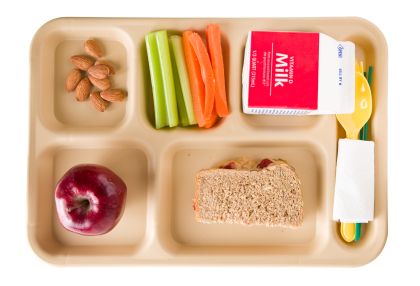
States show varied levels of readiness for the new rule.
Goodbye, cheese puffs and gummy bears. Hello, baked chips and fruit.
This is the message the U.S. Department of Agriculture (USDA) seems to send to schools in its recently-proposed “Smart Snacks in School” rule. The rule would impose tougher nutrition standards on “competitive food” – or food sold outside of regular meals – in schools that participate in certain federally-subsidized meal programs.
The proposed rule would implement provisions of the Healthy, Hunger Free Kids Act of 2010 (HHFKA) that require the Secretary of Agriculture to create “science-based nutrition standards” for non-meal foods – sometimes called “competitive food” because it competes with federally-subsidized lunch and breakfast meal programs by offering students alternatives.
The federal government already regulates nutrition standards for meals provided through the National School Lunch Program (NSLP) and the School Breakfast Program (SBP), among other programs. But competitive foods are currently subject only to minimal federal standards that ban the sale at meal times of “Foods of Minimal Nutritional Value” (FMNV), which only include a narrower category of foods like soda and hard candies. This leaves largely unregulated some foods sold in vending machines and in school stores, among other places in schools.
Some states, however, have implemented their own regulations for competitive foods. According to the Centers for Disease Control and Prevention (CDC), as of 2010, thirty-nine states had their own policies on competitive foods.
But these policies have varied widely. Some states regulate only the time and place of sale, and not the content of competitive foods. Other states make competitive food standards voluntary. Yet others apply standards only to elementary and middle schools.
The variation in current regulations among the states implies that some states will need to make more significant changes than others to comply with the USDA’s proposed rule, should it be finalized. The USDA has analyzed competitive food policies in the five states with the largest enrollment in NSLP-participating schools—California, Florida, Illinois, New York, and Texas—and found that none of these states met all of the proposed standards. However, California, Illinois, and New York City did meet some of them.
Additionally, many schools throughout the country participate in either the USDA’s Healthier US School Challenge (HUSSC) or the Alliance for a Healthier Generation’s Healthy Schools Program, both of which certify schools that comply with voluntary standards. According to the USDA, its voluntary HUSSC’s standards are comparable to the requirements in its proposed rule. Of the nearly 5,000 schools in the HUSSC, all have reportedly made progress toward complying with the proposed competitive food standards. USDA stated that the over 14,000 schools in the separate Healthy Schools Program run by the private Alliance for a Healthier Generation had made similar progress.
The USDA claims that its proposed rule “does not impose substantial or direct compliance costs on [s]tate and local governments.” Nevertheless, state agencies would have to oversee compliance with the rule and local agencies would need to ensure that the appropriate entities in charge of competitive food service at the schools kept records of receipts, nutritional labels, or other product information.
The USDA will be accepting public comment on its proposed rule through April 9, 2013.



